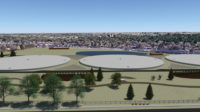In the thirsty West, where there is a growing need to find new water supplies, large water-diversion schemes have returned to the forefront of planning.
The controversial Yampa Pumpback project in Colorado proposes to divert 2,000 cu ft per second of water, or around 97 billion gallons a year, from the Yampa River into a new 500,000-acre-ft reservoir near Dinosaur National Monument in the northwestern part of the state.
From there, it would be pumped through a pipeline and tunnels nearly 250 miles east into a storage reservoir near Fort Collins, Colo. Cost estimates for the project range from $3.9 billion to $5 billion and up.
The second draft of a nearly 500-page plan for the project was released in early July. Regional water authorities, like the Northern Colorado Water Conservancy District in Berthoud, Colo., support the Yampa Pumpback plan despite growing questions about the viability of “trans-mountain” projects.
A half-dozen of those have been built in Colorado over several decades to move more than 500,000 acre ft of water a year from the Colorado River Basin and other Pacific watersheds west of the Continental Divide east to the Front Range, where most of the state’s population lives.
The state census says Colorado’s population is growing at nearly 1.6% per year, almost twice the national average, and most of the growth is happening in the cities along Interstate 25 north and south of Denver. State water officials argue that water reuse and conservation alone will not serve the state’s needs.
The Yampa project could help meet a projected 163-billion-gallon water shortage by 2050. Early spring flows in the Yampa can reach 6,000 cfs, and water officials estimate that more than 1 million acre ft of the Yampa flows directly into Utah. The new reservoir would capture that for use in Colorado, supporters say.
But critics, and especially environmentalists, say that large-scale diversion projects like the Yampa Pumpback do more harm than good, especially on rivers like the Yampa, which is one of the few remaining free-flowing rivers in the West.
“We believe that trans-basin diversions—big water grabs—are an antiquated idea,” says Kent Vertrees, a board member for Friends of the Yampa, a nonprofit that works to protect the river. “A large-scale consumptive project [like the Pumpback] will do irreparable damage to the river.”





